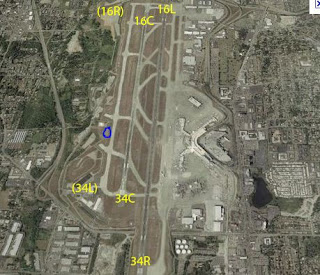Last week the Seattle Times had a front page story about the Northwest becoming warmer and wetter based on recently updated climate statistics at Seattle-Tacoma Airport. But can we use one observing site to reliably determine region climate trends? In my previous blog I noted that this is a real problem: one site is not necessarily representative of a region and besides it might have observing issues. And Sea Tac has such issues in spades: changes in the local environment, changes in sensors, and changing positions of the sensors.
But there is a related issue: although I believe that the threat of anthropogenic global warming forced mainly by CO2 and other greenhouse gases is extraordinarily serious and --quite frankly-- inevitable, I also worry about the integrity of our surface observations. I don't believe my field has given sufficient attention to the impact of development around our weather stations, or of poor placement of our thermometers near concrete, buildings, or other generators of heat.
So let us consider Seattle-Tacoma Airport, clearly the most reported station in western Washington and one frequently cited as a harbinger of climate change (such as in the Seattle Times).
Between 2004 and 2008 there was a huge change at the airport, one of the largest construction/earth moving projects in the region in years--the building of a third runway. In this blog I will ask the question: did the construction of the third runway have an impact on summer temperatures reported from the airport? My conclusion and that of my colleague Mark Albright is: it sure looks like it.
But first a few pictures. Here is a picture of Sea-Tac before the third runway was installed. I have also indicated the position of the National Weather Service/FAA temperature sensors (their ASOS system) by a blue circle (just to the west of the second runway).
Although it is hard to see, just to the west of the weather sensors the ground sloped down a hill (Sea-Tac is on a high spot), a hill that had lots of vegetation. During the summer, particularly during the afternoons, the winds are from the northwest, and thus the air reaching that sensor was from above that vegetated hill. Vegetation keeps daily temperatures down (mainly from evaporation of water--transpiration) and the higher you are above the surface in summer, the cooler the air.
In 2004 construction began on the third runway--a huge task. Massive amounts of fill were brought in to the west side of the airport--just where that vegetated hill was located. And a huge new concrete runway, with all kinds of taxiways and ancillary roads, were built. A massive change of the surface west of the sensor.
Here are two recent pictures of the current runway situation (with the blue circle showing the sensor position). Quite a change.
Here is a close of view of the sensors based from an image available on Google maps:
Now I did quite a lot of research to determine whether there were any temperature sensor changes recently (position, type, etc) at the airport and have reached lots of assistance from the folks at Sea Tac Airport and the National Weather Service. Based on their help, and the documentation available from the National Climatic Data Center, I think we can say, quite authoritatively, that the temperature sensor has has not been moved since 2002 ( it had been shifted a bit then in consideration of the third-runway construction, and there had been major moves/sensor changes in previous years).
OK, now lets answer the question. Did the runway change the summer climate at the airport? My colleague, Mark Albright, calculated the difference in summer temperatures (June, July, August) between Sea-Tac and an average of four nearby official reporting locations (Olympia, McMillan Reservoir near Tacoma, Kent, and Buckley).
Negative means that the neighbors are warmer than Sea-Tac, which you would expect since they are farther inland and generally south of Sea-Tac (which has some cooling influence from the Sound). You will see that Sea-Tac was generally cooler than those surrounding station (by roughly 1.5F) early in the period. And the slight shift in 2002 had little impact. But after construction began in 2004 (particularly in 2005 to 2006 when the heavy earth moving occurred) things changed: Sea-Tac temperatures warmed up by roughly 2F so it was the same or warmer than the surrounding, more inland, stations. I strongly suspect we are seeing the influence of the third runway.The impact of development at the runway is also suggested by looking at recent temperatures at truly neighboring observing locations (not all official). For example, here is a plot of temperatures during the afternoon of July 15th in the Sea-Tac neighborhood at 4 PM (click to enlarge). Sea-Tac is the warmest of the bunch at 74F!
Bottom line: It really looks that the third runway has significantly warmed summer temperatures at the airport. Thus, one must be really careful in assuming that any warming there is the result of some kind of greenhouse gas influence.
Now this is not the only site with problems, a very significant percentage of our observing sites have moved, had sensor changes, are in areas in which urbanization have occurred, or other issues. This makes it very difficult to use surface data to secure reliable information on regional temperature trends. It is possible, but one has to spend considerable time to remove the bad stations or make reasonable adjustments. Much more work needs to be done in this area.
















